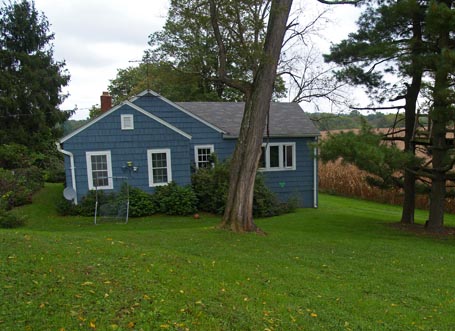 possible Sears kit house (with addition)We believed the original portion of this little cottage, where my friend and her family lived for years, to be a Sears, Roebuck and Company Modern Homes kit. Its walls and floors were all finished with wood or tile, not a smidge of plaster or Sheetrock -- except in the addition. I'm not sure if my fascination with the Sears kit houses of 1908-1940 was originally sparked by my friend's cottage or if the cottage merely reinforced my fascination. In either case, I continue to marvel at the genius of the Sears Modern Homes program, which endured until the Great Recession and pre-World War II building-material shortages took a devasting toll.
possible Sears kit house (with addition)We believed the original portion of this little cottage, where my friend and her family lived for years, to be a Sears, Roebuck and Company Modern Homes kit. Its walls and floors were all finished with wood or tile, not a smidge of plaster or Sheetrock -- except in the addition. I'm not sure if my fascination with the Sears kit houses of 1908-1940 was originally sparked by my friend's cottage or if the cottage merely reinforced my fascination. In either case, I continue to marvel at the genius of the Sears Modern Homes program, which endured until the Great Recession and pre-World War II building-material shortages took a devasting toll.
I was delighted to find an article in the May issue of Old-House Journal (on newsstands now) about the Sears, Roebuck kit houses of Hopewell, Virginia. I planned to link here to the story on the Old-House Journal website. However, I was disappointed to learn that the story is not yet available online, but, then, I made another discovery in the Old-House Journal article archives. There, I found "The Story on Sears" by Shirley Maxwell and James C. Massey. I'm not sure when the article was written, perhaps ages ago, but it's a great synopsis of how the Sears Modern Homes came to be, evolved, and, ultimately, ceased production.
The popularity of the kit-house concept tends to resurge every so often, as it did in the 2008 MOMA exhibit titled "Home Delivery, Fabricating the Modern Dwelling" which I wrote about here. It seems to me an idea that may again be gaining traction as we begin to emerge from the current recession and the dire lessons of living large and unsustainably. An updated, sustainable, human-scaled kit house, for the way people really live, may, once again, be in order.
by Katie Hutchison for House Enthusiast

